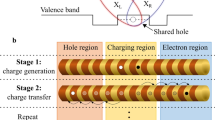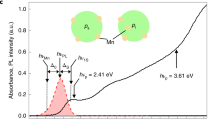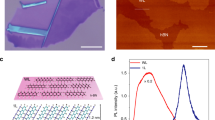Abstract
Solid films of colloidal quantum dots show promise in the manufacture of photodetectors and solar cells. These devices require high yields of photogenerated charges and high carrier mobilities, which are difficult to achieve in quantum-dot films owing to a strong electron–hole interaction and quantum confinement. Here, we show that the quantum yield of photogenerated charges in strongly coupled PbSe quantum-dot films is unity over a large temperature range. At high photoexcitation density, a transition takes place from hopping between localized states to band-like transport. These strongly coupled quantum-dot films have electrical properties that approach those of crystalline bulk semiconductors, while retaining the size tunability and cheap processing properties of colloidal quantum dots.
This is a preview of subscription content, access via your institution
Access options
Subscribe to this journal
Receive 12 print issues and online access
$259.00 per year
only $21.58 per issue
Buy this article
- Purchase on Springer Link
- Instant access to full article PDF
Prices may be subject to local taxes which are calculated during checkout






Similar content being viewed by others
References
Talapin, D. V. & Murray, C. B. PbSe nanocrystal solids for n- and p-channel thin film field-effect transistors. Science 310, 86–89 (2005).
Hansen, J. A. et al. Quantum-dot/aptamer-based ultrasensitive multi-analyte electrochemical biosensor. J. Am. Chem. Soc. 128, 2228–2229 (2006).
Konstantatos, G. et al. Ultrasensitive solution-cast quantum dot photodetectors. Nature 442, 180–183 (2006).
Coe, S., Woo, W. K., Bawendi, M. & Bulovic, V. Electroluminescence from single monolayers of nanocrystals in molecular organic devices. Nature 420, 800–803 (2002).
Klimov, V. I. et al. Optical gain and stimulated emission in nanocrystal quantum dots. Science 290, 314–317 (2000).
Leschkies, K. S., Beatty, T. J., Kang, M. S., Norris, D. J. & Aydil, E. S. Solar cells based on junctions between colloidal PbSe nanocrystals and thin ZnO films. ACS Nano 3, 3638–3648 (2009).
Choi, J. J. et al. PbSe nanocrystal excitonic solar cells. Nano Lett. 9, 3749–3755 (2009).
Gur, I., Fromer, N. A., Geier, M. L. & Alivisatos, A. P. Air-stable all-inorganic nanocrystal solar cells processed from solution. Science 310, 462–465 (2005).
Luther, J. M. et al. Schottky solar cells based on colloidal nanocrystal films. Nano Lett. 8, 3488–3492 (2008).
Ma, W., Luther, J. M., Zheng, H. M., Wu, Y. & Alivisatos, A. P. Photovoltaic devices employing ternary PbSxSe1–x nanocrystals. Nano Lett. 9, 1699–1703 (2009).
Pattantyus-Abraham, A. G. et al. Depleted-heterojunction colloidal quantum dot solar cells. ACS Nano 4, 3374–3380 (2010).
Ginger, D. S. & Greenham, N. C. Charge injection and transport in films of CdSe nanocrystals. J. Appl. Phys. 87, 1361–1368 (2000).
Yu, D., Wang, C. J. & Guyot-Sionnest, P. n-Type conducting CdSe nanocrystal solids. Science 300, 1277–1280 (2003).
Lee, J-S., Kovalenko, M. V., Huang, J., Chung, D. S. & Talapin, D. V. Band-like transport, high electron mobility and high photoconductivity in all-inorganic nanocrystal arrays. Nature Nanotech. 6, 348–352 (2011).
Tang, J. A. & Sargent, E. H. Infrared colloidal quantum dots for photovoltaics: fundamentals and recent progress. Adv. Mater. 23, 12–29 (2011).
Jarosz, M. V., Porter, V. J., Fisher, B. R., Kastner, M. A. & Bawendi, M. G. Photoconductivity studies of treated CdSe quantum dot films exhibiting increased exciton ionization efficiency. Phys. Rev. B 70, 195327 (2004).
Loef, R., Houtepen, A. J., Talgorn, E., Schoonman, J. & Goossens, A. Study of electronic defects in CdSe quantum dots and their involvement in quantum dot solar cells. Nano Lett. 9, 856–859 (2009).
Sambur, J. B., Novet, T. & Parkinson, B. A. Multiple exciton collection in a sensitized photovoltaic system. Science 330, 63–66 (2010).
Trinh, M. T. et al. In spite of recent doubts carrier multiplication does occur in PbSe nanocrystals. Nano Lett. 8, 1713–1718 (2008).
Trinh, M. T. et al. Anomalous independence of multiple exciton generation on different group IV–VI quantum dot architectures. Nano Lett. 11, 1623–1629 (2011).
Luther, J. M. et al. Structural, optical and electrical properties of self-assembled films of PbSe nanocrystals treated with 1,2-ethanedithiol. ACS Nano 2, 271–280 (2008).
Wolcott, A. et al. Anomalously large polarization effect responsible for excitonic red shifts in PbSe quantum dot solids. J. Phys. Chem. Lett. 2, 795–800 (2011).
Dollefeld, H., Weller, H. & Eychmuller, A. Particle–particle interactions in semiconductor nanocrystal assemblies. Nano Lett. 1, 267–269 (2001).
Artemyev, M. V., Woggon, U., Jaschinski, H., Gurinovich, L. I. & Gaponenko, S. V. Spectroscopic study of electronic states in an ensemble of close-packed CdSe nanocrystals. J. Phys. Chem. B 104, 11617–11621 (2000).
Moreels, L. et al. Composition and size-dependent extinction coefficient of colloidal PbSe quantum dots. Chem. Mater. 19, 6101–6106 (2007).
Talgorn, E. et al. Highly photoconductive CdSe quantum-dot films: influence of capping molecules and film preparation procedure. J. Phys. Chem. C 114, 3441–3447 (2010).
Talgorn, E. et al. Supercrystals of CdSe quantum dots with high charge mobility and efficient electron transfer to TiO2 . ACS Nano 4, 1723–1731 (2010).
Trinh, M. T., Houtepen, A. J., Schins, J. M., Piris, J. & Siebbeles, L. D. A. Nature of the second optical transition in PbSe nanocrystals. Nano Lett. 8, 2112–2117 (2008).
Dakovski, G. L., Lan, S., Xia, C. & Shan, J. Terahertz electric polarizability of excitons in PbSe and CdSe quantum dots. J. Phys. Chem. C 111, 5904–5908 (2007).
Murphy, J. E., Beard, M. C. & Nozik, A. J. Time-resolved photoconductivity of PbSe nanocrystal arrays. J. Phys. Chem. B 110, 25455–25461 (2006).
Schins, J. M. Thin-sample limit for time-resolved terahertz spectroscopy. Appl. Phys. Lett. 97, 1772110–1772112 (2010).
Savenije, T. J., de Haas, M. P. & Warman, J. M. The yield and mobility of charge carriers in smooth and nanoporous TiO2 films. Z. Phys. Chem. 212, 201–206 (1999).
Liu, Y. et al. Dependence of carrier mobility on nanocrystal size and ligand length in PbSe nanocrystal solids. Nano Lett. 10, 1960–1969 (2010).
Romero, H. E. & Drndic, M. Coulomb blockade and hopping conduction in PbSe quantum dots. Phys. Rev. Lett. 95, 156801 (2005).
Yu, D., Wang, C. J., Wehrenberg, B. L. & Guyot-Sionnest, P. Variable range hopping conduction in semiconductor nanocrystal solids. Phys. Rev. Lett. 92, 216802 (2004).
Houtepen, A. J., Kockmann, D. & Vanmaekelbergh, D. Reappraisal of variable-range hopping in quantum-dot solids. Nano Lett. 8, 3516–3520 (2008).
Roest, A. L., Houtepen, A. J., Kelly, J. J. & Vanmaekelbergh, D. Electron-conducting quantum-dot solids with ionic charge compensation. Faraday Discuss. 125, 55–62 (2004).
Mentzel, T. S. et al. Charge transport in PbSe nanocrystal arrays. Phys. Rev. B 77, 075316 (2008).
Chandler, R. E., Houtepen, A. J., Nelson, J. & Vanmaekelbergh, D. Electron transport in quantum dot solids: Monte Carlo simulations of the effects of shell filling, Coulomb repulsions, and site disorder. Phys. Rev. B 75, 085325 (2007).
Braun, C. L. Electric-field assisted dissociation of charge-transfer states as a mechanism of photocarrier generation. J. Chem. Phys. 80, 4157–4161 (1984).
Bruggeman, D. A. G. Calculation of various physics constants in heterogenous substances. Dielectricity constants and conductivity of mixed bodies from isotropic substances. Ann. Phys. 24, 636–664 (1935).
Brus, L. E. Electron–electron and electron–hole interactions in small semiconductor crystallites: the size dependence of the lowest excited electronic state. J. Chem. Phys. 80, 4403–4409 (1984).
Delerue, C. & Lannoo, M. Nanostructures: Theory and Modelling (Springer-Verlag, 2004).
Wehrenberg, B. L., Wang, C. J. & Guyot-Sionnest, P. Interband and intraband optical studies of PbSe colloidal quantum dots. J. Phys. Chem. B 106, 10634–10640 (2002).
Anderson, P. W. Absence of diffusion in certain random lattices. Phys. Rev. 109, 1492–1505 (1958).
Smith, B. B. & Nozik, A. J. Theoretical studies of electronic state localization and wormholes in silicon quantum dot arrays. Nano Lett. 1, 36–41 (2000).
Pepper, M., Pollitt, S., Adkins, C. J. & Stradling, R. A. Anderson localization in silicon inversion layers. Crit. Rev. Solid State 5, 375–384 (1975).
Kovalenko, M. V. et al. Quasi-seeded growth of ligand-tailored PbSe nanocrystals through cation-exchange-mediated nucleation. Angew. Chem. Int. Ed. 47, 3029–3033 (2008).
Han, Y., Mayer, D., Offenhausser, A. & Ingebrandt, S. Surface activation of thin silicon oxides by wet cleaning and silanization. Thin Solid Films 510, 175–180 (2006).
Acknowledgements
This work was supported by SenterNovem (project SELECT) and the Netherlands Organisation for Scientific Research (NWO), Division of Chemical Sciences (VICI award 700.53.443). The 3TU Centre for Sustainable Energy Technologies is acknowledged for financial support. A.J.H. acknowledges financial support through a NWO-VENI grant. The authors thank S. Patwardhan for useful discussions and M. Murra for the photograph of the film.
Author information
Authors and Affiliations
Contributions
E.T. and A.J.H. designed the experiment, analysed data and wrote the paper. E.T. performed TRMC experiments. Y.G. and M.A. synthesized the quantum dots and developed the film preparation procedure. Y.G. performed transient absorption measurements and simulations of the mobility. L.K. performed terahertz conductivity experiments. T.J.S. designed the temperature-dependent TRMC setup. J.M.S. developed the analytical deconvolution procedure. M.v.H. performed TEM experiments. H.S.J.v.d.Z. and L.D.A.S. gave conceptual advice.
Corresponding author
Ethics declarations
Competing interests
The authors declare no competing financial interests.
Supplementary information
Supplementary information
Supplementary information (PDF 3139 kb)
Rights and permissions
About this article
Cite this article
Talgorn, E., Gao, Y., Aerts, M. et al. Unity quantum yield of photogenerated charges and band-like transport in quantum-dot solids. Nature Nanotech 6, 733–739 (2011). https://doi.org/10.1038/nnano.2011.159
Received:
Accepted:
Published:
Issue Date:
DOI: https://doi.org/10.1038/nnano.2011.159
This article is cited by
-
Hierarchical carrier transport simulator for defected nanoparticle solids
Scientific Reports (2021)
-
Quantum dot solids showing state-resolved band-like transport
Nature Materials (2020)
-
Controlling the dimension of the quantum resonance in CdTe quantum dot superlattices fabricated via layer-by-layer assembly
Nature Communications (2020)
-
Confined yet free to go
Nature Materials (2020)
-
Bright colloidal quantum dot light-emitting diodes enabled by efficient chlorination
Nature Photonics (2018)



